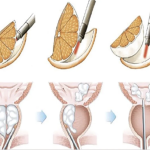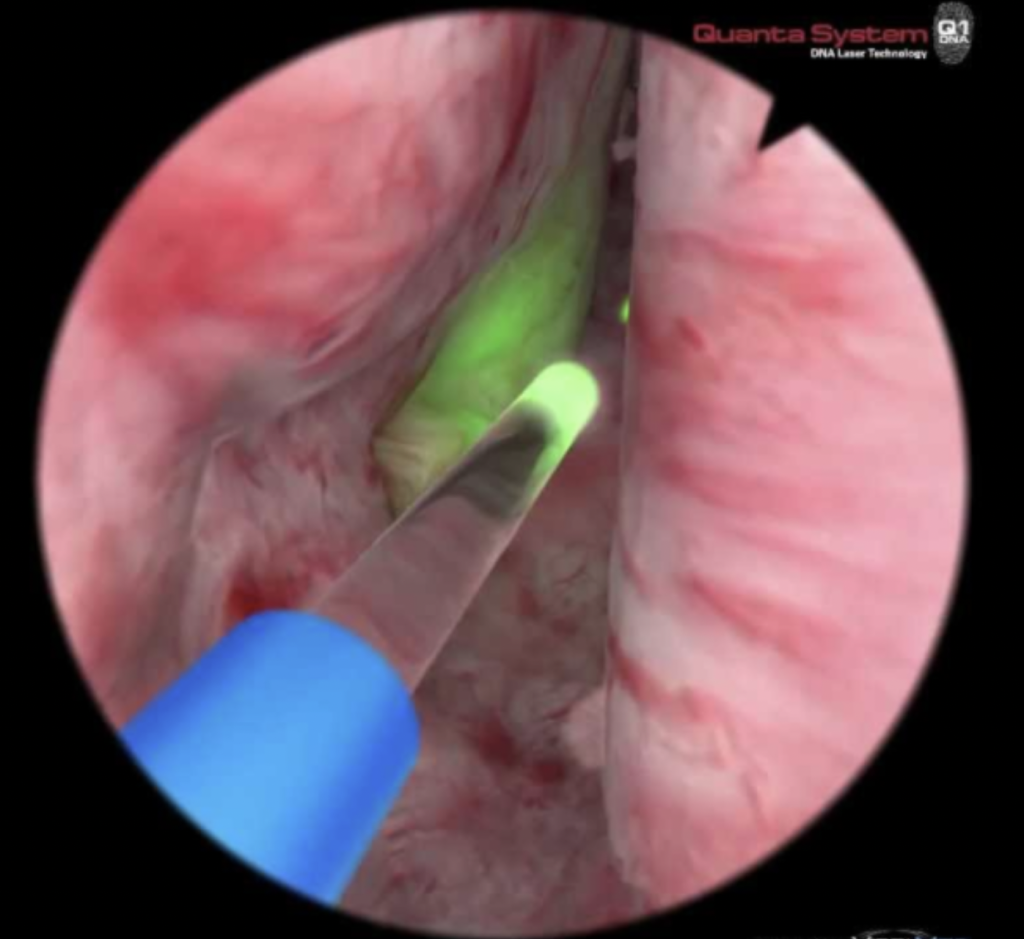
HoLEP Surgery – What is HoLEP (Holmium Laser Prostate Enucleation)?
23 July 2025
Prostate Surgery
1 August 2025ThuLEP Surgery - What is ThuLEP?
ThuLEP is an advanced surgical technique used to treat benign prostatic hyperplasia (BPH), a common condition in men as they age. This method involves using Thulium laser energy to remove the part of the prostate that is blocking the urinary tract by vaporizing it with the laser. This procedure creates a wider channel, allowing urine to flow more easily.ThuLEP has similar success rates to other laser techniques such as HoLEP (Holmium Laser Enucleation) but may offer certain advantages such as lower complication rates and shorter surgery times.
Features and Advantages of Thulium Fiber Laser
The Thulium fiber laser is the most advanced laser technology used in the ThuLEP procedure. Its unique features provide significant advantages for both the surgeon and the patient:

Technical Features:
- Balance of cutting and coagulation: Provides both cutting and bleeding control simultaneously
- Continuous energy output: Ensures high precision and smooth tissue separation
- Smaller fiber thickness: Easier maneuverability
Patient benefits:
- Minimal bleeding: High coagulation effect. Especially advantageous for patients using anticoagulants.
- Less heat dissipation: Surrounding tissues are protected, and the healing process is accelerated.
- Shorter surgery time: Tissue can be separated quickly and effectively.
- Reduced catheterization time and hospital stay: Ensures a more comfortable recovery.
- Smaller instruments can be used thanks to thin fiber technology: Reduced risk of trauma and complications.
Who is eligible for ThuLEP surgery?
- While the procedure can be performed on all prostate patients with a prostate size of 30 grams or larger today, it is particularly recommended for patients with enlarged prostates.
Especially for:
- Patients who do not respond to medication or cannot take medication
- Patients with severe urinary symptoms
- In patients with low urinary flow rate (Qmax < 15 ml/s)
- In patients with residual urine in the bladder after urination (PVR≥ 50 ml)
- May be recommended in patients with catheter dependence.
What happens on the day of the ThuLEP surgery?
Your urologist (or a member of their team) will briefly review your medical history and medications and will confirm the surgery with you again to obtain your consent. An anesthesiologist will discuss general anesthesia or spinal anesthesia options with you. The anesthesiologist will also talk to you about pain management after the procedure. You may be given compression stockings before the procedure and an injection of a blood-thinning medication to help prevent blood clots from forming and traveling to your lungs. Your medical team will decide whether you need to continue these precautions after you return home.How is ThuLEP Administered?
The procedure is performed under general or spinal anesthesia. The surgeon insert a special telescope (resectoscope) into the urethra and uses a thulium laser to separate the enlarged part of the prostate from its capsule. These tissues are then broken down using a special device called a morcellator and removed from the body. At the end of the procedure, a catheter is placed in the bladder to ensure drainage of urine and bladder irrigation for a few days.
The ThuLEP procedure can be performed using three primary techniques:
- Three-Lobe Technique:
The two lateral lobes and the central lobe of the prostate are removed separately. This is the classic and most commonly used technique. - Two-lobe Technique:
After the lateral lobes are removed, the central lobe is extracted. This technique can be completed in a shorter time and is relatively easier to learn. - En-bloc Technique:
The entire prostate is removed in one piece. Since the surgical plane only needs to be defined once, the procedure may take less time.

Advantages of ThuLEP
- Shorter surgery time: The en-bloc and two-lobe techniques take an average of 35 minutes less than the three-lobe technique.
- Lower energy consumption: The Thulium laser operates at lower energy levels, reducing the risk of damage to surrounding tissues.
- Less bleeding: The coagulative effect of the Thulium laser reduces the risk of bleeding during and after surgery.
- Faster recovery: With a short hospital stay and rapid catheter removal, patients can return to normal activities sooner.
- Safe for large prostates: It serves as an alternative to open surgery, especially for large prostates weighing 80 grams or more.
What are the risks and complications of ThuLEP surgery?
ThuLEP is generally a safe procedure, but in some cases the following complications may occur:
- Urinary incontinence (usually temporary)
- Urinary tract infection
- Bleeding
- Bladder wall injury
- Temporary frequent and sudden urge to urinate
Postoperative Recovery and Follow-up After ThuLEP Surgery
Patients typically stay in the hospital for one night. The catheter is removed within 1–2 days on average. Mild burning and frequent urination are normal in the first few days. These symptoms decrease over several weeks.
According to evaluations conducted during 3-month follow-ups, there is a significant increase in post-surgery urination speed, a noticeable decrease in complaints related to swelling, a significant decrease in PSA levels, and a significant decrease in the amount of urine remaining in the bladder.
ThuLEP is a safe, effective, and minimally invasive method for treating benign prostatic hyperplasia. Although there are differences between the three surgical techniques in terms of procedure duration and energy usage, long-term clinical outcomes are similar. The surgeon's mastery and experience with the technique, rather than the type of surgical technique, has been the determining factor in the outcomes.
